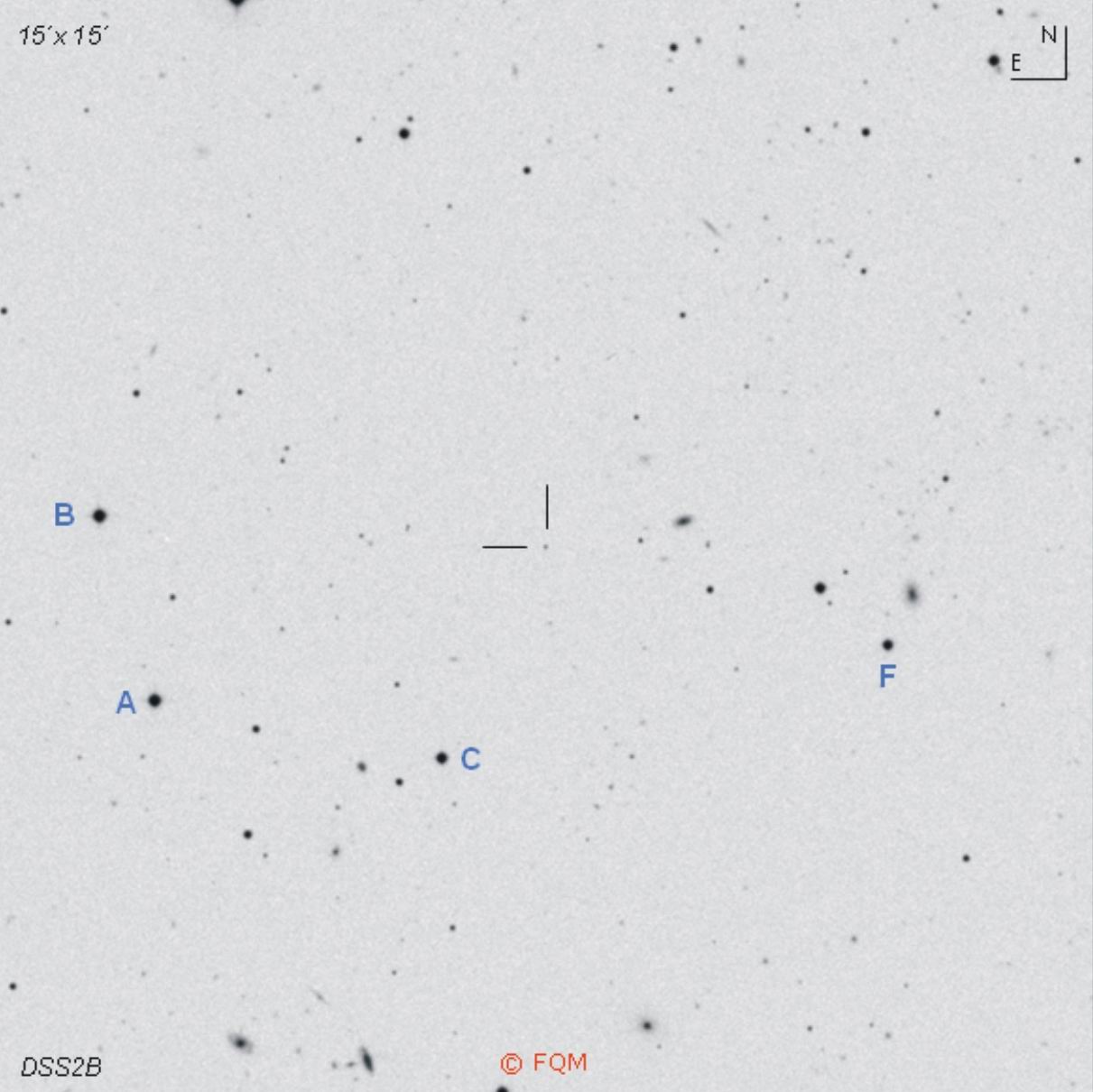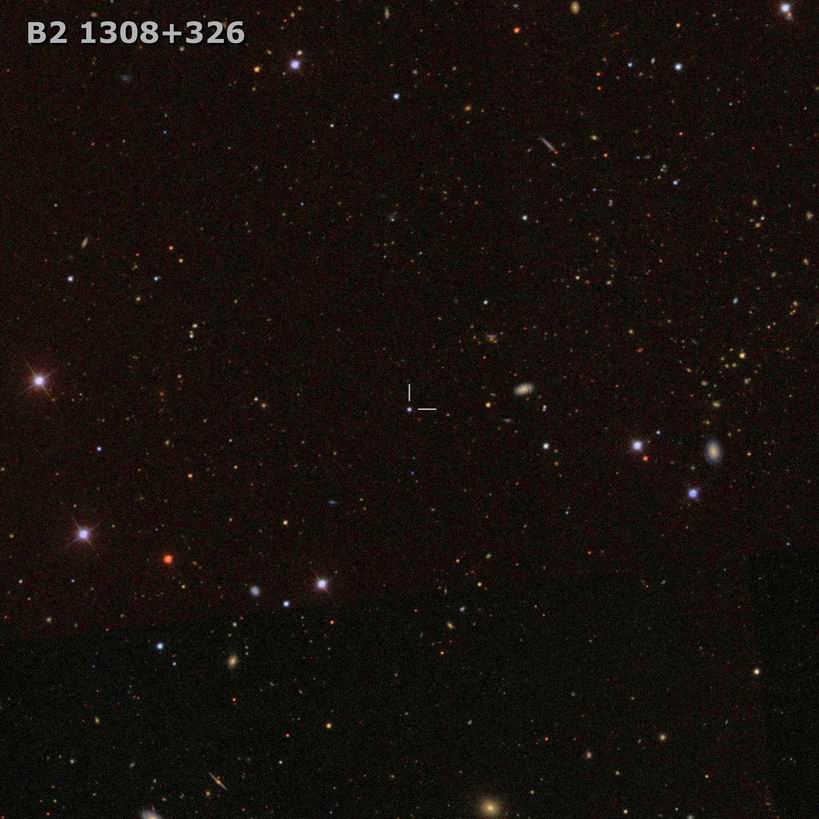
| Frankfurt Quasar Monitoring |
| AU CVn (B2 1308+32, OP+313) |
| Cross-Identifications | 7C 1308+3236, TXS 1308+326, 1ES 1308+326 B2 1308+32, GC 1308+32, OP 313, US 371 IRAS F13080+3237, 87GB 130808.6+323654 2MASSi J1310286+322043, 1AXG J131028+3220 SDSS J131028.66+322043.7, RX J1310.4+3220 CSO 836, 2E 2900, FIRST J131028.6+322043 GALEXASC J131028.69+322044.4, 1308+326 WMAP J1310+3221, 1FGL J1310.6+3222 |
| Equat. coordinates | RA 13 10 28.7 DE +32 20 44 (J2000) |
| Constellation | Canes Venatici |
| Type | QSO (1) / BL Lac (3) |
| Redshift |
z=0.997 (1) (3) / z=0.998 (2) |
| Distance (2) (4) |
3224 Mpc |
| Total mag range (mv) (5) (6) | 12.9 - 19.6 |
| Catalog Magnitude | 15.24 (1) / 18.0 g (2) |
| Absolute Magnitude (1) | -28.6 MB |
| Light Travel-Time (2) | 7.515 × 109 yrs |

Comparison stars
| star | B | V | Rc | Ic |
| A | 13.53 (0.03) | 13.05
(0.04) |
12.71
(0.04) |
12.38
(0.04) |
| B | 13.38
(0.02) |
12.73
(0.03) |
12.35
(0.03) |
12.03 (0.03) |
| C | 14.39
(0.07) |
13.58 (0.03)1 | 13.20 (0.03)1 | 12.84 (0.03)1 |
| F | 14.67
(0.07) |
14.31
(0.10) |
13.88
(0.20) |
13.72
(0.14) |


| AU
CVn = B2 1308+32 is a variable blazar in the southern-most part of
Canes Venatici, close to the constellation Coma Berenices. AU
CVn
was discovered in 1959 as a variable stellar object on POSS plates. It
was classified as a new variable star (CSVS 6997). Since then, it has been cataloged with
the designation AU CVn in the GCVS. In
1968, a new radio
source (OP+313) was found at
the position of AU CVn, which was also cataloged by the Bologna Radio
Survey (B2). A faint 19-mag stellar
object was identified as the
optical counterpart in
1972. In 1977, it was found that both the radio source and the variable
star refer to the same object. The extragalactic nature of this
variable radio source was proved after
the first accurate redshift of AU
CVn was
determined in 1978 (z=0.997).
Since 1984, the new identity of AU
CVn has been listed in the GCVS.
Initially,
the extragalactic object AU
CVn
was classified as a BL
Lac object. In 1992, it was
reclassified as a
quasar, located at the whopping distance of about 7.5×109 light-years. Today, both classifications for AU CVn, quasar and BL Lac object, can be found in the literature. Besides
the radio, this blazar has been known also as a
blue emission object (CSO) and as a source of infrared (IRAS, 2MASS), X-rays (1ES,
RX, 1AXG) and gamma rays (1FGL). AU CVn is a large amplitude variable object ranging between v=13m.94 and B=20m.0 (literature). Usually, the object remains faint, so it is a favorite target for CCD observers. Visual observers may only observe this quasar during the rare outbursts. The last bright outbursts occurred in 2002, June/July 2019, May 2022, turn of the year 2024/2025 and the latest superoutburst in early July 2022 with a new optical alltime maximum of 12.9mv (see light curve above). Both CCD observers and visual observers shall use the comparison stars given above. Another sequence was published by Miller et al. (1984). ____________
The
position of quasar
AU CVn lies only a few degrees away from the north galactic pole. Here we have
an unobstructed view into the
universe, so there is a large number of bright and interesting
quasi-stellar objects around to
observe. Two bright and variable BL Lac objects are located within some 11° to
the WSW
in Coma Berenices: W Com
and B2
1215+30. Moving about 19° to the ENE will show another two bright quasi-stellar objects in Bootes. The first one is MRK 478, a bright 14-mag quasar. The second one is PKS 1424+240, a bright and slightly variable 14-mag BL Lacertae object. For deep sky observers, the sky in the near vicinity of AU CVn offers two bright and remarkable galaxy pairs. First I like to advise you of NGC 4631 and NGC 4656, a bright interacting pair in Com, some 6° E. NGC 4631 is a slightly distorted edge-on spiral, accompanied by elliptical NGC 4627. NGC 4656 is a more strongly affected spiral, also dubbed the "hockey stick". This galaxy pair is an easy task for telescopes of 8- to 10-inch of aperture. The second galaxy pair is located in CVn, some 4.5° N of quasar AU CVn. This pair consists of NGC 5033, a bright and large open arm spiral. Its gravitational partner, NGC 5005, lies only 40´ to the NE, which is a tightly wound 10.5-mag spiral. NGC 5005 also harbours an AGN (S3b) at its centre, which appears as a remarkably bright star-like nucleus. Do you like to take another deep view into the deep sky? 320 million light-years is O.K. for you? Then sweep your telescope 5° to the south and you will meet Abell 1656, the Coma galaxy cluster. This rich galaxy cluster is dominated by its two 12-mag giant ellipticals NGC 4884 and NGC 4874. In late 2011, a new investigation found out that the supermassive black hole at the centre of NGC 4884 has an incredible mass of about 10×109 solar masses - one of the most massive yet known. Finally, do not forget about globular cluster Messier 3, located 7.8° SE in Bootes, an impressive showpiece for medium and large aperture telescopes. |
| Colla, G., Fanti, C., et al. 1970, A&AS, 1, 281; A catalogue of 3235 radio sources at 408 MHz. Fan, J.H., Lin, R.G. 2000, ApJ, 537, 101; Optical variability and periodicity analysis for Blazars. I. Light curves for radio-selected BL Lacertae objects. Fiorucci, M., Tosti, G., Rizzi, N. 1998, PASP, 110, 105; VRI Photometry of Stars in the fields of 16 Blazars. Gabuzda, D.C., Kollgaard, R.I., et al. 1992, ApJ, 410, 39; Is 1308+326 a BL Lacertae object or a quasar? Gottlieb, E.W., Chaisson, L.J., Liller, W. 1977, IAUC. 3140; B2 1308+32 = CSVS 6997 = OP 313. Grueff, G., Vigotti, M., 1972, A&AS 6, 1. Khopolov, P.N., et al. 1984; General Catalogue of Variable Stars, Nauka Publishing House, Moscow. Kurochkin, N.E. 1959, PZ, 12, 409; New variable stars in SA 57. Kukarkin, B.V., Kurochkin, N.E. 1977, IAUC 3051; CSVS 6997. Miller, J.S., French, H.B., et al. 1978; in: Pittsburgh Conf. on BL Lac Objects, p.176. Miller, H.R., Wilson, J.W., et al. 1984, A&AS, 57, 353; Photoelectric comparison sequences in the fields of B2 1308+326 and 1418+54. Pollock, J.T., Pica, A.J., Smith, A.G., et al. 1979, AJ, 84, 11; Long-term optical variations of 20 violently variable extragalactic radio sources. Puschell, J.J., Stein, W.A., Jones, T.W., et al. 1979, ApJ, 227, L11; B2 1308+326 - Photometry and polarization during the outburst of 1978 spring. Smith, P.S., Balonek, T.J., et al. 1985, AJ, 90, 1184; UBVRI Field Comparison Stars for Selected Active Quasars and BL Lacertae Objects. Steinicke, W.; Katalog heller Quasare und BL Lacertae Objekte; Umkirch 1998. Steinicke, W.; Extragalactic Objects discovered as variable stars; Umkirch 2000. Tytler, D., Fan, X.-M. 1992, ApJS, 79, 1; Systematic QSO Emission-Line Velocity Shifts and new unbiased Redshifts. Usher, P. 1981, ApJS, 46, 117; Faint blue objects at high galactic latitude. I - Palomar Schmidt field centered on selected area 57. Véron-Cetty, M.-P., Véron, P. 2001, A&A 374, 92; A Catalogue of Quasars and Active Nuclei: 10th edition. Véron-Cetty, M.-P., Véron, P. 2003, A&A 412, 399; A Catalogue of Quasars and Active Nuclei: 11th edition. Véron-Cetty, M.-P., Véron, P. 2006, A&A 455, 776; A Catalogue of Quasars and Active Nuclei: 12th edition. Véron-Cetty, M.-P., Véron, P. 2010, A&A 518, 10; A Catalogue of Quasars and Active Nuclei: 13th edition. |